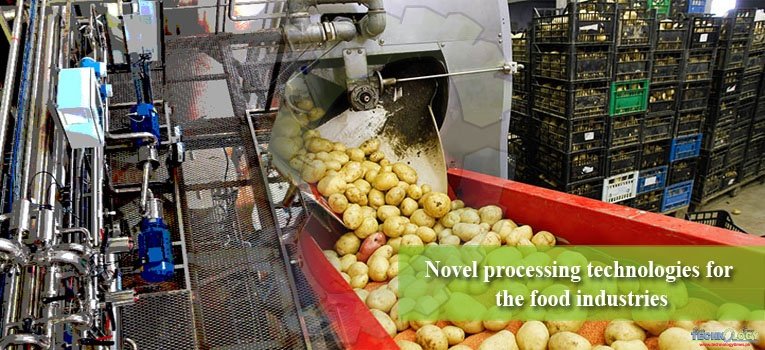The need for novel processing technologies in the food industry is a direct result of consumer demand for fresh, high quality and healthy products that are free from chemical preservatives and yet are safe.

The trend towards the use of “natural” ingredients, (colors, flavors or preservatives) although technically challenging, has created the need for research into milder and more energy efficient but equally effective processing technologies that are able to preserve the structure and thus,
Function and benefits of novel ingredients whilst at the same time maintaining the nutritional and other food product qualities. Improvement of product quality has always been the main goal of food and beverage manufacturers. Novel processing technologies such as high-pressure processing (HPP), pulsed electric field (PEF) and cold plasma are thought to be among the most promising of novel technologies.
- High Pressure Processing (HPP)
HPP is a non-thermal pasteurization technique whereby products are held at pressures typically between 300 and 600 MPa for up to 10 minutes. The advantages of HPP over the conventional thermal processing techniques involve reduced process times and thus reduced heat damage, as well as retention of product flavor, texture, color and vitamins.
However, microbial spore survival during processing requires this technique to be used in conjunction with another hurdle such as low pH or refrigeration.
HPP is shown to inactivate pathogenic and spoilage bacteria, yeasts, molds and viruses; however, its efficacy is limited against bacterial spores and enzymes. Factors such as the type of microorganism, food composition, pH and water activity are shown to affect its microbial inactivation efficiency.
HPP wasn’t used in the commercial preservation of foods until 1990 but has since been used successfully while the number of commercial applications is growing worldwide.
HPP has been employed in the processing of a number of liquid and semi-solid foods such as fruit juices, purees, smoothies, jellies and guacamole. High capital expenditure and limited throughput are its main current limitations.
- Pulsed Electric field (PEF)
Recognized for its ability to inactivate bacteria present in liquid food products at low temperatures, PEF is a food preservation technique whereby the food to be processed is exposed to a pulsed high voltage field for less than 1 second.
Studies have shown that PEF processing results in better retention and storage stability of carotenoids, phenolic compounds and flavonols, in comparison to thermal processing. It can be industrially implemented to produce juices that better resemble the freshly squeezed, mainly with regards to their aroma profile.
PEF has the potential to replace thermal techniques for the pasteurization and sterilization of liquid foods due to the retention of the products’ nutritional value, sensory characteristics, safety and overall quality profile, yet at lower operational costs. Others believe that PEF could be a suitable technique for use with additional processes/hurdles such as mild thermal treatment or control via pH/water activity.
Studies have shown that combining the PEF treatment at moderate temperatures with the presence of an antimicrobial, effective against both Gram-positive and -negative pathogenic bacteria, would significantly enhance process efficiency, reduce the number of pulses and outlet temperature and lead to significant energy cost savings.
PEF efficacy towards microbial inactivation mainly depends on the intensity of the electric field, the pulse width, treatment time (number of pulses times pulse duration), pulse waveshape, temperature (operational temperatures of 50–60oC result in increased microbial inactivation) and product conductivity.
High conductivity foods are not thought to be suitable for treatment with PEF, neither are those with a high salt content or liquid products containing particulates. PEF lethality is also affected by the lifecycle stage of the target micro-organisms with rapidly growing and dividing microbal populations being the most sensitive while those in stationary or lag phases showing some resistance.
- Cold Plasma
Plasma is defined as the fourth state of matter that is energetically distinguishable from solids, liquids and gases and can either be thermal or non-thermal, depending on the conditions in which they are created.
Plasma is a source of different antimicrobial substances including UV photons, charged particles, and reactive species such as superoxide, hydroxyl radicals, nitric oxide and ozone.
Very high temperature and/or pressure conditions, thus a significant level of power, are required to obtain thermal plasmas, whereas non-thermal plasma use significantly less power as they may be generated by electric or magnetic discharges and can be obtained at lower pressures, thus generating significant industrial interest.
Although a relatively unexplored decontamination technology, cold plasma has found applications in the sanitisation of the surface of fresh produce, liquid products (e.g., juice), as well as equipment surfaces used in food processing and food packaging.
Cold plasma is thought to be an effective alternative to thermally based microbial inactivation methods having comparable microbial inactivation properties against major pathogens while having little or no effect on the product’s nutritional or other quality.
However, cell density has been shown to affect the efficacy of cold plasma processing with upper cell layers acting as physical barriers to underlying cells in complex bacterial multilayer structures (e.g., bacterial biofilms), thus potentially affecting the practical application of the technique to the food industry.
The need for enhanced food safety and quality, without compromising the nutritional and sensory characteristics of foods, has created an increasing interest in low-temperature innovative food processes.
These emerging technologies mainly rely on physical processes that use ambient or moderately elevated temperatures and short treatment times to inactivate microorganisms.
Given that factors affecting the efficacy of the different processes, mainly related to the properties of the food matrix to be processed, can lead to significant variability in their efficacy, it would be difficult to apply a one-for-all-rule on the application of these mild processing conditions.
More research is required to establish and expand the industrial applications of the different technologies and overcome high capital costs that may delay industrial adoption.
Author: Muhammad Hassan, M.Sc. (Hons.) Food Technology, University of Agriculture, Faisalabad.